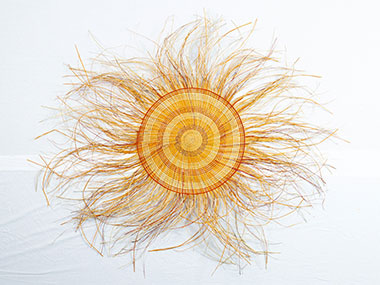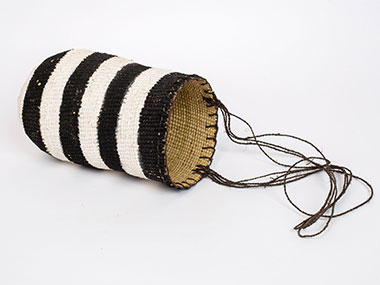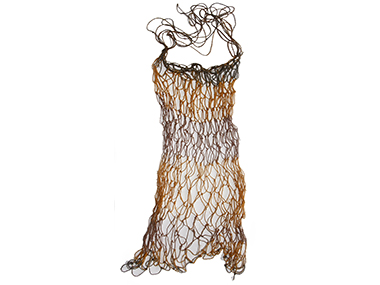FIBRE ALCHEMY

One of the glorious pandanus fibre mats made at Gapuwiyak, Arnhemland by Margaret Djarrbalabal Malibirr
Posted by Jeremy Eccles | 02.10.19
Dates:
04.10.19
: 22.12.19
Location: The Goods Shed, Claremont, Perth, WA
From ghost net sculpture to body amour, a new fibre art survey show The Alchemists, brought together by FORM in Perth, draws together diverse contemporary weaving practice from Indigenous artists and art centres across Australia.
Opening at The Goods Shed, Claremont on Friday, 4th October, 'The Alchemists' features groundbreaking new artworks by artists ranging from Groote Eylandt in the Gulf of Carpentaria to the Mornington Peninsula, exploring a continually evolving artistic practice which remains grounded in a traditional reliance on found or natural materials.
Among them is Telstra NATSIAA Youth award-winning Kieren Karritpul, who translates to canvas the traditional weavings of his mother, grandmother and great grandmother at Merrepen in the Northern Territory. The irony here is that the leader of the neighbouring Durrmu Art Centre – Regina Wilson – only took up her distinctive painting of weaving because the men in her community said she couldn't reproduce stories! And she also has a show opening in Sydney at the Michael Reid Gallery.
From Cairns, artist and fashion curator, Grace Lillian Lee crafts the palm frond weave adornments distinctive to her Torres Strait Islander heritage into high fashion; and artists from the Torres Strait and Cape York are putting their own spin on transforming the wreckage of plastic fishing nets found washed up on their beaches into art as activism: coiled and plaited into marine animals, some with debris in their stomachs, highlighting the impact of these ghost nets on the marine environment.
In Victoria, artists are using kelp and possum skin carriers, incorporating feathers from black swans, tawny frogmouths and lorikeets; in the Pilbara, fine bundles of minarri grass collected from Country are wrapped in threads of brightly coloured wool; and in Ramingining in the Top End, senior weavers are collaborating with urban designers, forming homewares like lamp shades styled from traditional woven Yolngu mats. More of this can be seen at the fashionable furniture design store, Koskela in Sydney – which has commissioned 13 different communities now to make work for them - and at the Tarnanthi Festival in Adelaide later this month.
FORM curator Sharmila Wood claims that the Indigenous fibre art of Australia expresses a community of practice unified by the ability of artists to transform raw materials into creative expressions of story and place. “The works, and their creators, perform a most special mixture of artistry and alchemy,” Ms Wood says. “With 'The Alchemists', we have a fascinating opportunity to appreciate how contemporary fibre art is shaped by economic and ecological influences, by change and the adoption of new methods and a mix of old and new materials.”
“Connected to women’s knowledge of plant materials and harvesting, fibre art is inextricably linked to seasonal availability of resources, and the transformation of raw natural materials into dyes, yarn and threads.”
Meanwhile, in Virginia, the US of A, 'With Her Hands : Women’s Fiber Art from Gapuwiyak : The Louise Hamby Gift' is an exhibition featuring selections from a gift of 100 artworks recently donated to the Kluge-Ruhe Museum by Dr. Louise Hamby which addresses topics of tradition and innovation, gender roles, generational change and relationships to place.
It runs until 5th April 2020.
In 1991, Louise Hamby acquired her first basket from northern Australia, and over the next three decades she's amassed one of the largest and finest collections of Indigenous Australian fibre art in the world. Between 1995-2001, Hamby’s PhD research took her to Gapuwiyak, where she developed close relationships with a group of senior fibre artists including Lucy Malirrimurruwuy Waṉapuyngu, Rudy Munguluma Biḏingal and Nancy Walinyinawuy Guyana. In November 2017, Dr. Hamby established the Hamby Collection at Kluge-Ruhe as a permanent repository for the research and exhibition of Aboriginal fibre art, through the donation of 100 stunning works from Gapuwiyak. This significant gift will make Kluge-Ruhe a world centre for the study of contemporary Aboriginal women’s fibre art.
The diverse artworks in the Hamby donation were made between 1996 and 2013 by 25 women artists. There are thirty necklaces made from a variety of seeds, shells and nuts; mats and various forms of basketry (straight baskets, conical baskets, string bags, purses and bathi) made from natural and dyed pandanus palm. Also included are a variety of sculptures (a canoe, a crocodile and a kangaroo) and ceremonial objects (armbands and headbands).
Kluge curator, Henry Skerritt explained, “These 100 works mark the start of a truly transformational gift to Kluge-Ruhe. They are the some of the finest examples of women’s fibre work produced in Australia in the last quarter century. The depth and quality of the Hamby Collection will allow Kluge-Ruhe to shed light on this important but understudied section of Indigenous Australian art”.
Perhaps Indigenous fibre art is understudied in the US, but it's certainly not undersighted in Australia at the moment!
URL: https://www.form.net.au/who-we-are
Share this:
»  del.icio.us
»
del.icio.us
»  Digg it
»
Digg it
»  reddit
»
reddit
»  Google
»
Google
»  StumbleUpon
»
StumbleUpon
»  Technorati
»
Technorati
»  Facebook
Facebook
Contact Details

A black and White dilly bag called 'Bidiyunawuy Mindirr', made by by Helen Ganalmirriwuy in Gapuwiyak

A magnificently modulated String Bag, woven by Lucy Malirrimuruwuy Wanapuyngu and collected by Louise Hamby for the Kluge Ruhe Museum
Further Research
Artists: Grace Lillian Lee | Kieren Karritpul | Lucy Malirrimurruwuy Waṉapuyngu | Nancy Walinyinawuy Guyana | Regina Wilson | Rudy Munguluma Biḏingal
News Tags: fibre art | FORM | Henry Skerritt | Jeremy Eccles | Kluge Ruhe | Koskela | Louise Hamby | Tarnanthi Festival
News Categories: Australia | Blog | Event | Exhibition | Feature | Festival | Industry | News | North America
Exhibition Archive
- 11.05.20 | BIDYADANGA CLOSE-UP
- 07.05.20 | Boomerang Back to the Start
- 29.04.20 | Cooked???
- 24.04.20 | Mrs Ngallametta
- 23.04.20 | NATSIAA Pre-Selections Revealed
- 20.04.20 | CIAF 2020
- 10.04.20 | Marginally Good News
- 06.04.20 | ON & OFF IN ABORIGINAL ART
- 26.03.20 | Out on Country!
- 19.03.20 | BIENNALE OF SYDNEY 2020
- 13.03.20 | LAURIE NILSEN
- 03.03.20 | EMILY v CLIFFORD
- 02.03.20 | The Ephemeral and the Ineradicable
- 25.02.20 | WADJUK IN THE BLACK
- 17.12.19 | Sotheby's NY Inaugural Aboriginal Art Auction
Advertising

